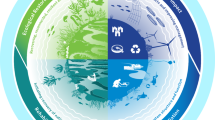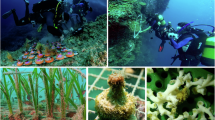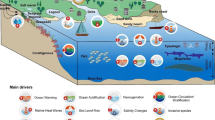Abstract
The biodiversity of marine and coastal habitats is experiencing unprecedented change. While there are well-known drivers of these changes, such as overexploitation, climate change and pollution, there are also relatively unknown emerging issues that are poorly understood or recognized that have potentially positive or negative impacts on marine and coastal ecosystems. In this inaugural Marine and Coastal Horizon Scan, we brought together 30 scientists, policymakers and practitioners with transdisciplinary expertise in marine and coastal systems to identify new issues that are likely to have a significant impact on the functioning and conservation of marine and coastal biodiversity over the next 5–10 years. Based on a modified Delphi voting process, the final 15 issues presented were distilled from a list of 75 submitted by participants at the start of the process. These issues are grouped into three categories: ecosystem impacts, for example the impact of wildfires and the effect of poleward migration on equatorial biodiversity; resource exploitation, including an increase in the trade of fish swim bladders and increased exploitation of marine collagens; and new technologies, such as soft robotics and new biodegradable products. Our early identification of these issues and their potential impacts on marine and coastal biodiversity will support scientists, conservationists, resource managers and policymakers to address the challenges facing marine ecosystems.
This is a preview of subscription content, access via your institution
Access options
Access Nature and 54 other Nature Portfolio journals
Get Nature+, our best-value online-access subscription
$32.99 / 30 days
cancel any time
Subscribe to this journal
Receive 12 digital issues and online access to articles
$119.00 per year
only $9.92 per issue
Buy this article
- Purchase on SpringerLink
- Instant access to full article PDF
Prices may be subject to local taxes which are calculated during checkout



Similar content being viewed by others
Data availability
The datasets generated during and/or analysed during the current study are available from figshare https://doi.org/10.6084/m9.figshare.19703485.v1. Source data are provided with this paper.
References
Díaz, S. et al. Set ambitious goals for biodiversity and sustainability. Science 370, 411–413 (2020).
Sutherland, W. J. & Woodroof, H. J. The need for environmental horizon scanning. Trends Ecol. Evol. 24, 523–527 (2009).
Sutherland, W. J. et al. Ten years on: a review of the first global conservation horizon scan. Trends Ecol. Evol. 34, 139–153 (2019).
Sutherland, W. J. et al. A horizon scan of global conservation issues for 2010. Trends Ecol. Evol. 25, 1–7 (2010).
Sutherland, W. J. et al. A horizon scan of global conservation issues for 2016. Trends Ecol. Evol. 31, 44–53 (2016).
Sutherland, W. J. et al. A horizon scanning assessment of current and potential future threats facing migratory shorebirds. Ibis 154, 663–679 (2012).
Bowman, D. M. J. S. et al. Vegetation fires in the Anthropocene. Nat. Rev. Earth Environ. 1, 500–515 (2020).
Tang, W. et al. Widespread phytoplankton blooms triggered by 2019–2020 Australian wildfires. Nature 597, 370–375 (2021).
Silva, L. G. M. et al. Mortality events resulting from Australia’s catastrophic fires threaten aquatic biota. Glob. Change Biol. 26, 5345–5350 (2020).
Abram, N. J., Gagan, M. K., McCulloch, M. T., Chappell, J. & Hantoro, W. S. Coral reef death during the 1997 Indian Ocean Dipole linked to Indonesian wildfires. Science 301, 952–955 (2003).
Solomon, C. T. et al. Ecosystem consequences of changing inputs of terrestrial dissolved organic matter to lakes: current knowledge and future challenges. Ecosystems 18, 376–389 (2015).
Sully, S. & van Woesik, R. Turbid reefs moderate coral bleaching under climate related temperature stress. Glob. Change Biol. 26, 1367–1373 (2021).
Blain, C. O., Hansen, S. C. & Shears, N. T. Coastal darkening substantially limits the contribution of kelp to coastal carbon cycles. Glob. Change Biol. 27, 5547–5563 (2021).
Stewart, B. D. et al. Metal pollution as a potential threat to shell strength and survival in marine bivalves. Sci. Total Environ. 755, 143019 (2021).
Roberts, D. A. et al. Ocean acidification increases the toxicity of contaminated sediments. Glob. Change Biol. 19, 340–351 (2013).
Hauton, C. et al. Identifying toxic impact of metals potentially released during deep-sea mining—a synthesis of the challenges to quantifying risk. Front. Mar. Sci. 4, 368 (2017).
Chaudhary, C. et al. Global warming is causing a more pronounced dip in marine species richness around the equator. Proc. Natl Acad. Sci. USA 118, e2015094118 (2021).
Burrows, M. T. et al. Geographical limits to species-range shifts are suggested by climate velocity. Nature 507, 492–495 (2014).
Yasuhara, M. et al. Past and future decline of tropical pelagic biodiversity. Proc. Natl Acad. Sci. USA 117, 12891–12896 (2020).
Pandolfi, J. M. et al. Are U.S. coral reefs on the slippery slope to slime? Science 307, 1725–1726 (2005).
Hixson, S. M. & Arts, M. T. Climate warming is predicted to reduce omega-3, long-chain, polyunsaturated fatty acid production in phytoplankton. Glob. Change Biol. 22, 2744–2755 (2016).
Hicks, C. C. et al. Harnessing global fisheries to tackle micronutrient deficiencies. Nature 574, 95–98 (2019).
Colombo, S. M. et al. Projected declines in global DHA availability for human consumption as a result of global warming. Ambio 49, 865–880 (2020).
Lam, V. W. et al. Climate change, tropical fisheries and prospects for sustainable development. Nat. Rev. Earth Environ. 1, 440–454 (2020).
Antacli, J. C. et al. Increase in unsaturated fatty acids in Antarctic phytoplankton under ocean warming and glacial melting scenarios. Sci. Total Environ. 790, 147879 (2021).
Maire, E. et al. Micronutrient supply from global marine fisheries under climate change and overfishing. Curr. Biol. 18, 4132–4138 (2021).
Lim, Y. S., Ok, Y. J., Hwang, S. Y., Kwak, J. Y. & Yoon, S. Marine collagen as a promising biomaterial for biomedical applications. Mar. Drugs 17, 467 (2019).
Xu, N. et al. Marine-derived collagen as biomaterials for human health. Front. Nutr. 8, 702108 (2021).
Vieira, H., Leal, M. C. & Calado, R. Fifty shades of blue: how blue biotechnology is shaping the bioeconomy. Trends Biotechnol. 38, 940–943 (2020).
Ben-Hasan, A. et al. China’s fish maw demand and its implications for fisheries in source countries. Mar. Policy 132, 104696 (2021).
Sadovy de Mitcheson, Y., To, A. W. L., Wong, N. W., Kwan, H. Y. & Bud, W. S. Emerging from the murk: threats, challenges and opportunities for the global swim bladder trade. Rev. Fish. Biol. Fish. 29, 809–835 (2019).
Brownell, R. L. Jr et al. Bycatch in gillnet fisheries threatens critically endangered small cetaceans and other aquatic megafauna. Endang. Species Res. 40, 285–296 (2019).
Webb, T. J., Vanden Berghe, E. & O’Dor, R. K. Biodiversity’s big wet secret: the global distribution of marine biological records reveals chronic under-exploration of the deep pelagic ocean. PLoS ONE 5, e10223 (2010).
St. John, M. A. et al. A dark hole in our understanding of marine ecosystems and their services: perspectives from the mesopelagic community. Front. Mar. Sci. 3, 31 (2016).
Thomsen, L. et al. The oceanic biological pump: rapid carbon transfer to depth at continental margins during winter. Sci. Rep. 7, 10763 (2017).
Roberts, C. M., Hawkins, J. P., Hindle, K., Wilson, R. W. & O’Leary, B. C. Entering the Twilight Zone: The Ecological Role and Importance of Mesopelagic Fishes (Blue Marine Foundation, 2020)
Cavan, E. L., Laurenceau-Cornec, E. C., Bressac, M. & Boyd, P. W. Exploring the ecology of the mesopelagic biological pump. Prog. Oceanogr. 176, 102125 (2019).
Levin, L. A. et al. Climate change considerations are fundamental to management of deep‐sea resource extraction. Glob. Change Biol. 26, 4664–4678 (2020).
Li, Z. et al. Continuous electrical pumping membrane process for seawater lithium mining. Energy Environ. Sci. 14, 3152–3159 (2021).
Jin, M., Gai, Y., Guo, X., Hou, Y. & Zeng, R. Properties and applications of extremozymes from deep-sea extremophilic microorganisms: a mini review. Mar. Drugs 17, 656 (2019).
Mbow, C. et al. in IPCC Special Report on Climate Change and Land (eds Shukla, P.R. et al.) 437–550 (IPCC, 2019).
Christie, N., Smyth, K., Barnes, R. & Elliott, M. Co-location of activities and designations: a means of solving or creating problems in marine spatial planning? Mar. Pol. 43, 254–261 (2014).
Mayer-Pinto, M., Dafforn, K. A. & Johnston, E. L. A decision framework for coastal infrastructure to optimize biotic resistance and resilience in a changing climate. BioScience 69, 833–843 (2019).
Wang, C. M. & Wang, B. T. in ICSCEA 2019 (eds Reddy, J. N. et al.) 3–29 (Springer, 2020).
Ross, C. T. F. & McCullough, R. R. Conceptual design of a floating island city. J. Ocean Technol. 5, 120–121 (2010).
Dong, Y.-w, Huang, X.-w, Wang, W., Li, Y. & Wang, J. The marine ‘great wall’ of China: local- and broad-scale ecological impacts of coastal infrastructure on intertidal macrobenthic communities. Divers. Distrib. 22, 731–744 (2016).
Flikkema, M. M. B., Lin, F.-Y., van der Plank, P. P. J., Koning, J. & Waals, O. Legal issues for artificial floating islands. Front. Mar. Sci. 8, 619462 (2021).
Richir, J., Bray, S., McAleese, T. & Watson, G. J. Three decades of trace element sediment contamination: the mining of governmental databases and the need to address hidden sources for clean and healthy seas. Environ. Int. 149, 106362 (2021).
Zhao, Y. et al. A review on battery market trends, second-life reuse, and recycling. Sustain. Chem. 2, 167–205 (2021).
Li, W., Lee, S. & Manthiram, A. High‐Nickel NMA: a cobalt‐free alternative to NMC and NCA cathodes for lithium‐ion batteries. Adv. Mater. 32, 2002718 (2020).
Ghaffarivardavagh, R., Afzal, S. S., Rodriguez, O. & Adib, F. in SIGCOMM ’20 Proc. 19th ACM Workshop on Hot Topics in Networks 125–131 (Association for Computing Machinery, 2020).
Hazen, E. L. et al. Ontogeny in marine tagging and tracking science: technologies and data gaps. Mar. Ecol. Prog. Ser. 457, 221–240 (2012).
Davies, T. E. et al. Tracking data and the conservation of the high seas: opportunities and challenges. J. Appl. Ecol. 58, 2703–2710 (2021).
Aracri, S. et al. Soft robots for ocean exploration and offshore operations: a perspective. Soft Robot. https://doi.org/10.1089/soro.2020.0011 (2021).
Li, G. et al. Self-powered soft robot in the Mariana Trench. Nature 591, 66–71 (2021).
Philamore, H., Ieropoulos, I., Stinchcombe, A. & Rossiter, J. Toward energetically autonomous foraging soft robots. Soft Robot. 3, 186–197 (2016).
Manfra, L. et al. Biodegradable polymers: a real opportunity to solve marine plastic pollution? J. Hazard. Mater. 416, 125763 (2021).
Kim, D., Kim, H. & An, Y. J. Effects of synthetic and natural microfibers on Daphnia magna: are they dependent on microfiber type? Aquat. Toxicol. 240, 105968 (2021).
Degli-Innocenti, F., Bellia, G., Tosin, M., Kapanen, A. & Itävaara, M. Detection of toxicity released by biodegradable plastics after composting in activated vermiculite. Polym. Degrad. Stab. 73, 101–106 (2001).
Macreadie, P. I. et al. The future of blue carbon science. Nat. Commun. 10, 3998 (2019).
Short, R. E. et al. Harnessing the diversity of small-scale actors is key to the future of aquatic food systems. Nat. Food 2, 733–741 (2021).
Watson, J. E. M. et al. Set a global target for ecosystems. Nature 578, 360–362 (2020).
Obura, D. O. et al. Integrate biodiversity targets from local to global levels. Science 373, 746 (2021).
Barnes, M. D., Glew, L., Wyborn, C. & Craigie, I. D. Prevent perverse outcomes from global protected area policy. Nat. Ecol. Evol. 2, 759–762 (2018).
Grorud-Colvert, K. et al. The MPA Guide: a framework to achieve global goals for the ocean. Science 373, eabf0861 (2021).
Jefferson, R. L., McKinley, E., Griffin, H., Nimmo, A. & Fletcher, S. Public perceptions of the ocean: lessons for marine conservation from a global research review. Front. Mar. Sci. 8, 711245 (2021).
Potts, T., Pita, C., O’Higgins, T. & Mee, L. Who cares? European attitudes towards marine and coastal environments. Mar. Pol. 72, 59–66 (2016).
Bennett, N. J. et al. Towards a sustainable and equitable blue economy. Nat. Sustain. 2, 991–993 (2019).
Jouffray, J.-B., Blasiak, R., Norström, A. V., Österblom, H. & Nyström, M. The blue acceleration: the trajectory of human expansion into the ocean. One Earth 2, 43–54 (2020).
Zheng, Y. & Walsham, G. Inequality of what? An intersectional approach to digital inequality under Covid-19. Inf. Organ. 31, 100341 (2021).
Blythe, J. L., Armitage, D., Bennett, N. J., Silver, J. J. & Song, A. M. The politics of ocean governance transformations. Front. Mar. Sci. 8, 634718 (2021).
Brennan, C., Ashley, M. & Molloy, O. A system dynamics approach to increasing ocean literacy. Front. Mar. Sci. 6, 360 (2019).
Stoll-Kleemann, S. Feasible options for behavior change toward more effective ocean literacy: a systematic review. Front. Mar. Sci. 6, 273 (2019).
Bennett, N. J. et al. Advancing social equity in and through marine conservation. Front. Mar. Sci. 8, 711538 (2021).
Short, R. E. et al. Review of the evidence for oceans and human health relationships in Europe: a systematic map. Environ. Int. 146, 106275 (2021).
Mukherjee, N. et al. The Delphi technique in ecology and biological conservation: applications and guidelines. Methods Ecol. Evol. 6, 1097–1109 (2015).
Sutherland, W. J. et al. A 2021 horizon scan of emerging global biological conservation issues. Trends Ecol. Evol. 36, 87–97 (2021).
Acknowledgements
This Marine and Coastal Horizon Scan was funded by Oceankind. S.N.R.B. is supported by EcoStar (DM048) and Cefas (My time). R.C. acknowledges FCT/MCTES for the financial support to CESAM (UIDP/50017/2020, UIDB/50017/2020, LA/P/0094/2020) through national funds. O.D. is supported by CSIC Uruguay and Inter-American Institute for Global Change Research. J.E.H.-R. is supported by the Whitten Lectureship in Marine Biology. S.A.K. is supported by a Natural Environment Research Council grant (NE/S00050X/1). P.I.M. is supported by an Australian Research Council Discovery Grant (DP200100575). D.M.P. is supported by the Marine Alliance for Science and Technology for Scotland (MASTS). A.R.P. is supported by the Inter-American Institute for Global Change Research. W.J.S. is funded by Arcadia. A.T. is supported by Oceankind. M.Y. is supported by the Deep Ocean Stewardship Initiative and bioDISCOVERY. We are grateful to everyone who submitted ideas to the exercise and the following who are not authors but who suggested a topic that made the final list: R. Brown (colocation of marine activities), N. Graham and C. Hicks (altered nutritional content of fish), A. Thornton (soft robotics), A. Vincent (fish swim bladders) and T. Webb (mesopelagic fisheries).
Author information
Authors and Affiliations
Contributions
J.E.H.-R. and A.T. contributed equally to the manuscript. J.E.H.-R., A.T. and W.J.S. devised, organized and led the Marine and Coastal Horizon Scan. D.J.A., S.N.R.B., I.M.C., M.P.D., B.J.G., S.A.K., E.M. and L.S.P. formed the core team and are listed alphabetically in the author list. All other authors, R.C., O.D., S.D., E.L.J., H.K., P.I.M., A.M., A.W.N.M., D.O.O., D.M.P., A.R.P., A.J.R., I.R.S., P.V.R.S., B.D.S., P.M.T., G.J.W., T.A.W. and M.Y. are listed alphabetically. All authors contributed to and participated in the process and all were involved in writing and editing the manuscript.
Corresponding authors
Ethics declarations
Competing interests
The authors declare no competing interests.
Peer review
Peer review information
Nature Ecology & Evolution thanks Camille Mellin, Prue Addison and the other, anonymous, reviewer(s) for their contribution to the peer review of this work.
Additional information
Publisher’s note Springer Nature remains neutral with regard to jurisdictional claims in published maps and institutional affiliations.
Supplementary information
Supplementary Information
Supplementary text and Tables 1 and 2.
Source data
Source Data Fig. 3
Issue number, final rank and proportion heard of for each issue in round 1 and round 2.
Rights and permissions
About this article
Cite this article
Herbert-Read, J.E., Thornton, A., Amon, D.J. et al. A global horizon scan of issues impacting marine and coastal biodiversity conservation. Nat Ecol Evol 6, 1262–1270 (2022). https://doi.org/10.1038/s41559-022-01812-0
Received:
Accepted:
Published:
Issue date:
DOI: https://doi.org/10.1038/s41559-022-01812-0
This article is cited by
-
Meta-analysis indicates better climate adaptation and mitigation performance of hybrid engineering-natural coastal defence measures
Nature Communications (2024)
-
3D ocean assessments reveal that fisheries reach deep but marine protection remains shallow
Nature Communications (2024)
-
Mining and extraction in the Arctic – a nordic perspective on sustainability and near-term challenges
Mineral Economics (2024)
-
Diet of non-breeding leach’s storm-petrels (Hydrobates leucorhous) in the sub-polar frontal zone of the North Atlantic
Marine Biology (2024)
-
Marine ecosystem-based management: challenges remain, yet solutions exist, and progress is occurring
npj Ocean Sustainability (2024)



